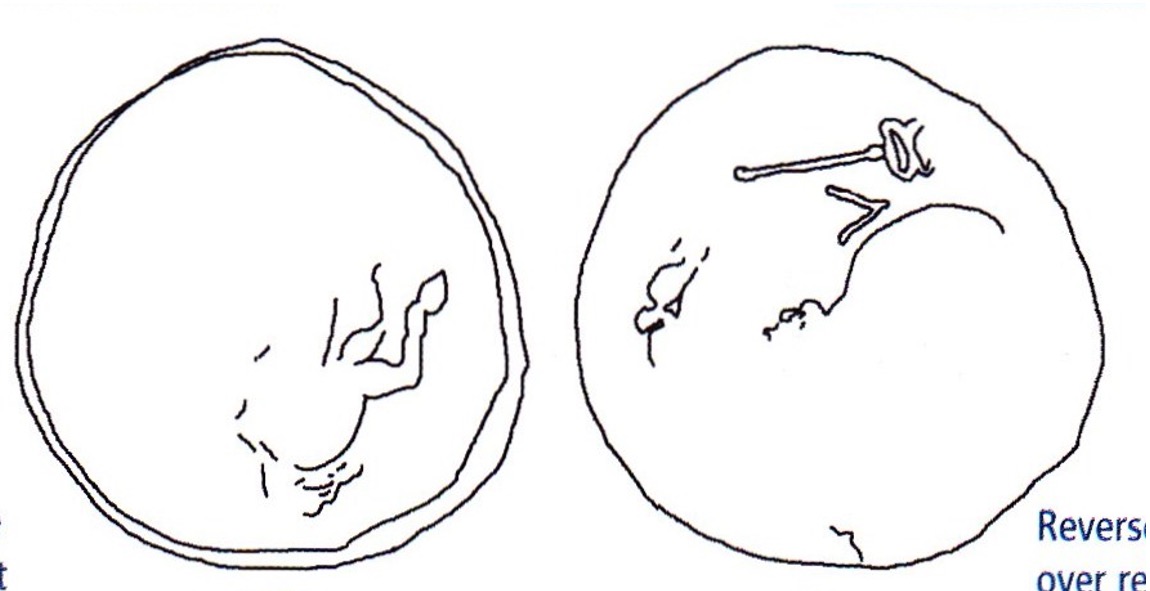343 BCE - 340 BCE | TAPAΣ
Overstriking coin
SO 1356 - Taras over Leucas.jpg
Overstruck variety
Taras on Corinth (Leukas) - MacDonald 2009, 14 overstruck variety.jpg
[1]
1356 Leucas (drawing).jpg
Description
| ObverseInscription or printing placed on the obverse.:
|
Youth on horse right, crowning horse, below a second youth examines horse's hoof, in right field, Φ
|
ReverseInscription or printing placed on the reverse.:
|
TAPAΣ (Greek) Male character (Taras or Phalanthos), nude, seated sideways on dolphin left, holding oinoche in one hand and trident and shield in other. Below, E and wave pattern.
|
Mint and issuing power
| MintIdentifies the place of manufacture or issue of a numismatic object.:
|
Taras
|
Ancient regionAncient region.
|
Calabria
|
Modern countryModern country: Italy
|
AuthorityIdentifies the issuing power. The authority can be "pretended" when the name or the portrait of X is on the coin but he/she was not the issuing power. It can also be "uncertain" when there is no mention of X on the coin but he/she was the issuing power according to the historical sources:
|
|
Chronology
| FromIdentifies the initial date in a range assigned in a numismatic context. 343 BCE toIdentifies the final date in a range assigned in a numismatic context.. 340 BCE
|
Classical 480-323 BC  periodTime period of the numismatic object. periodTime period of the numismatic object.
|
Physical description
MetalThe physical material (usually metal) from which an object is made.: Silver 
|
WeightWeight of the numismatic object (in grams). in grams: 7.887.88 g <br />7,880 mg <br />
|
DenominationTerm indicating the value of a numismatic object. Examples: tetradrachm, chalkous, denarius.: nomos
|
AxisDescribes the directional relationship between the obverse and reverse of a numismatic object.: 77 mm <br />0.7 cm <br />
|
|
|
|
References
| Coin referenceReference of the Coin:
|
Fischer-Bossert 1999, n° 696, MacDonald 2002, p. 64, MacDonald 2009, p. 19-20, n° 12
|
Coin series referenceReference to coin series study:
|
Fischer-Bossert 19991Fischer-Bossert 1999, group 50, n° 696 (V262/R543), MacDonald 20022MacDonald 2002, p. 64, MacDonald 20093MacDonald 2009, p. 19-20, n° 12, HGC 14HGC 1, n° 785
|
| Coin series web referenceCoin series web references:
|
|
Description
| ObverseInscription or printing placed on the obverse.:
|
Λ Pegasus flying right (visible on obverse: rear leg, rear, tail of Pegasus, top of Λ)
|
ReverseInscription or printing placed on the reverse.:
|
Head of Athena right, wearing Corinthian helmet. Behind, Λ and kerykeion (visible on reverse: back of helmet, traces of locks of hair, kerykeion and left side of Λ).
|
Mint and issuing power
| MintIdentifies the place of manufacture or issue of a numismatic object. ᵖ:
|
Leucas
|
Ancient regionAncient region. ᵖ
|
Acarnania
|
Modern countryModern country: Greece
|
AuthorityIdentifies the authority in whose name (explicitly or implicitly) a numismatic object was issued. ᵖ:
|
|
Chronology
| FromIdentifies the initial date in a range assigned in a numismatic context. 360 BCE toIdentifies the final date in a range assigned in a numismatic context.. 340 BCE
|
Classical 480-323 BC  periodTime period of the numismatic object. periodTime period of the numismatic object.
|
Physical description
| DenominationTerm indicating the value of a numismatic object. Examples: tetradrachm, chalkous, denarius. ᵖ:
|
stater 
|
|
|
References
| Coin type referenceReference to coin series study ᵖ:
|
Calciati 19905Calciati 1990, Leukas n° 92-95, the differences between the numbers being stylistic. The reference on p. 416 at the end of entry no. 92 to overstrikes should cite no. 47-54 rather than 44-54.
|
References
- ^ Fischer-Bossert, Wolfgang (1999), Chronologie der Didrachmenprägung von Tarent, 510-280 v. Chr., Berlin, De Gruyter, xvii, 495 p., [84] pl.
- ^ MacDonald, David (2002), "Sicilian and Southern Italian overstrikes over Pegasoi," Nomismatika Chronika 21, p. 55-64.
- ^ Macdonald, David (2009), Overstruck Greek coins: studies in Greek chronology and monetary theory, Whitman Publishing, Atlanta.
- ^ Hoover, Oliver D. (2018), The Handbook of Greek Coinage Series, Volume 1. Handbook of Coins of Italy and Magna Graecia, Sixth to First Centuries BC., Lancaster-London, 2018, lxi, 527 pages, 23 cm
- ^ Calciati, Romolo (1990), Pegasi, Mortara, Edizioni I.P..
 Traces of the overstruck variety
Traces of the overstruck variety

